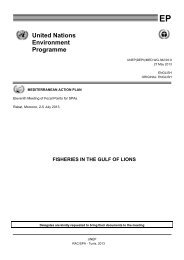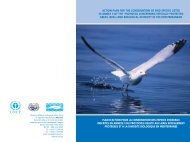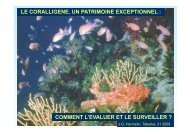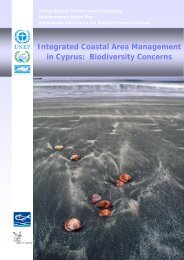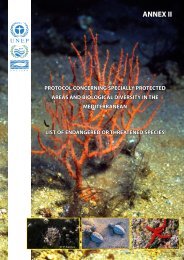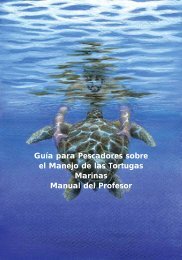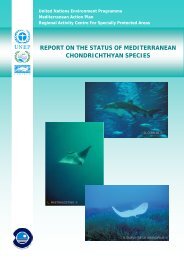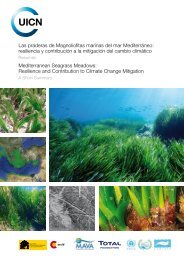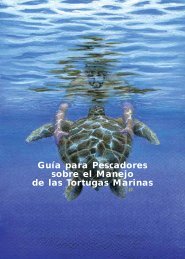Proceedings of the Second Mediterranean Symposium on Marine
Proceedings of the Second Mediterranean Symposium on Marine
Proceedings of the Second Mediterranean Symposium on Marine
Create successful ePaper yourself
Turn your PDF publications into a flip-book with our unique Google optimized e-Paper software.
FLORISTIC SIMILARITY AND DISCONTINUITY IN<br />
PHYTOGEOGRAPHIC MEDITERRANEAN REGIONS<br />
Giuseppe GIACCONE, Giovanni FURNARI & Mario CORMACI<br />
Dipartimento di Botanica dell'Università di Catania, via A. L<strong>on</strong>go 19, I-95125 Catania, Italy<br />
ABSTRACT<br />
Both floristic and geobotanic characteristics <str<strong>on</strong>g>of</str<strong>on</strong>g> <str<strong>on</strong>g>the</str<strong>on</strong>g> benthic macroalgal flora <str<strong>on</strong>g>of</str<strong>on</strong>g> Italy are<br />
discussed. The flora, obtained from literature records since 1950, c<strong>on</strong>sists <str<strong>on</strong>g>of</str<strong>on</strong>g> 869 (510<br />
Rhodophyta, 205 Phaeophyta and 154 Chlorophyta) taxa accepted under current<br />
tax<strong>on</strong>omy. Ceramiales, Fucophyceae and Chlorophyceae <str<strong>on</strong>g>of</str<strong>on</strong>g> such a flora were separately<br />
compared with corresp<strong>on</strong>ding tax<strong>on</strong>omic lists <str<strong>on</strong>g>of</str<strong>on</strong>g> <str<strong>on</strong>g>the</str<strong>on</strong>g> following <str<strong>on</strong>g>Mediterranean</str<strong>on</strong>g> regi<strong>on</strong>s:<br />
Spain; France; Greece and Turkey; Libya, Egypt and Levant States (Syria, Leban<strong>on</strong> and<br />
Israel); Morocco, Algeria and Tunisia. From that comparis<strong>on</strong> it appears that <str<strong>on</strong>g>the</str<strong>on</strong>g> benthic<br />
macroalgal flora <str<strong>on</strong>g>of</str<strong>on</strong>g> <str<strong>on</strong>g>the</str<strong>on</strong>g> Italian coast is <str<strong>on</strong>g>the</str<strong>on</strong>g> richest in species, probably because it was <str<strong>on</strong>g>the</str<strong>on</strong>g><br />
most studied especially in <str<strong>on</strong>g>the</str<strong>on</strong>g> last years. Hierarchical clustering <str<strong>on</strong>g>of</str<strong>on</strong>g> <str<strong>on</strong>g>the</str<strong>on</strong>g> above lists based<br />
<strong>on</strong> both floristic and phytogeographic characteristics were carried out and <str<strong>on</strong>g>the</str<strong>on</strong>g> results<br />
were expressed in dendrograms from which a noticeable floristic similarity am<strong>on</strong>g <str<strong>on</strong>g>the</str<strong>on</strong>g><br />
lists can be drawn since <str<strong>on</strong>g>the</str<strong>on</strong>g> lists are linked above <str<strong>on</strong>g>the</str<strong>on</strong>g> 50% level <str<strong>on</strong>g>of</str<strong>on</strong>g> importance excepting<br />
those <str<strong>on</strong>g>of</str<strong>on</strong>g> <str<strong>on</strong>g>the</str<strong>on</strong>g> Libya, Egypt and Levant States (30 to 50%), which could represent a floristic<br />
disc<strong>on</strong>tinuity. However, such a disc<strong>on</strong>tinuity, due to <str<strong>on</strong>g>the</str<strong>on</strong>g> low number <str<strong>on</strong>g>of</str<strong>on</strong>g> species recorded<br />
in that area could depend besides <strong>on</strong> <str<strong>on</strong>g>the</str<strong>on</strong>g> insufficient floristic knowledge, <strong>on</strong> both<br />
geomorphologic characteristics <str<strong>on</strong>g>of</str<strong>on</strong>g> coast and paleoclimatic events like sapropel crises. But,<br />
from dendrograms based <strong>on</strong> chorological spectra, it results a more marked degree <str<strong>on</strong>g>of</str<strong>on</strong>g><br />
similarity am<strong>on</strong>g <str<strong>on</strong>g>the</str<strong>on</strong>g> lists that are linked above <str<strong>on</strong>g>the</str<strong>on</strong>g> 75% level <str<strong>on</strong>g>of</str<strong>on</strong>g> importance.<br />
The first floristic knowledge <str<strong>on</strong>g>of</str<strong>on</strong>g> <str<strong>on</strong>g>the</str<strong>on</strong>g> benthic marine macroalgae <str<strong>on</strong>g>of</str<strong>on</strong>g> Italy is mainly due to<br />
papers published in <str<strong>on</strong>g>the</str<strong>on</strong>g> sec<strong>on</strong>d half <str<strong>on</strong>g>of</str<strong>on</strong>g> <str<strong>on</strong>g>the</str<strong>on</strong>g> XIX century by C. Agardh (1822-23; 1828),<br />
J. Agardh (1842, 1851-1863), Ardiss<strong>on</strong>e (1883, 1886-87), Kützing (1849, 1854-69),<br />
Meneghini (1842-46).<br />
Some more authors report, in <str<strong>on</strong>g>the</str<strong>on</strong>g>ir papers, algae from limited and/or particular areas: for<br />
example De T<strong>on</strong>i & Levi (1885-88), Hauck (1882-85), Naccari (1828), Schiffner (1914-<br />
26), Zanardini (1841, 1843, 1847, 1858, 1860-71), report algae <strong>on</strong>ly from <str<strong>on</strong>g>the</str<strong>on</strong>g> Adriatic<br />
Sea; Solms-Laubach (1881), Delle Chiaje (1829), Reinke (1878), Berthold (1884),<br />
Valiante (1883), Falkenberg (1879, 1901), Mazza (1902), from <str<strong>on</strong>g>the</str<strong>on</strong>g> Gulf <str<strong>on</strong>g>of</str<strong>on</strong>g> Naples;<br />
o<str<strong>on</strong>g>the</str<strong>on</strong>g>rs like Tornabene (1846), Philippi (1837), Langenbach (1873), Borzì (1886),<br />
Picc<strong>on</strong>e (1889), Spinelli (1905), <strong>on</strong>ly from Sicilian coast.<br />
Species quoted in <str<strong>on</strong>g>the</str<strong>on</strong>g> above papers, almost all reported in <str<strong>on</strong>g>the</str<strong>on</strong>g> huge Sylloge algarum by<br />
De T<strong>on</strong>i (1889-1924), form <str<strong>on</strong>g>the</str<strong>on</strong>g> "historical" benthic macroalgal flora <str<strong>on</strong>g>of</str<strong>on</strong>g> <str<strong>on</strong>g>the</str<strong>on</strong>g> Italian coast.<br />
De T<strong>on</strong>i's Sylloge, which represents <str<strong>on</strong>g>the</str<strong>on</strong>g> compendium <str<strong>on</strong>g>of</str<strong>on</strong>g> <str<strong>on</strong>g>the</str<strong>on</strong>g> algal floristic knowledge to<br />
that date, marks <str<strong>on</strong>g>the</str<strong>on</strong>g> c<strong>on</strong>clusi<strong>on</strong> <str<strong>on</strong>g>of</str<strong>on</strong>g> <str<strong>on</strong>g>the</str<strong>on</strong>g> first seas<strong>on</strong> <str<strong>on</strong>g>of</str<strong>on</strong>g> algological studies <str<strong>on</strong>g>of</str<strong>on</strong>g> Italian coast.<br />
Then, <strong>on</strong>e must wait <str<strong>on</strong>g>the</str<strong>on</strong>g> sixties for <str<strong>on</strong>g>the</str<strong>on</strong>g> beginning <str<strong>on</strong>g>of</str<strong>on</strong>g> a sec<strong>on</strong>d seas<strong>on</strong> <str<strong>on</strong>g>of</str<strong>on</strong>g> algological<br />
ACTES DU DEUXIEME SYMPOSIUM MEDITERRANEEN SUR LA VEGETATION MARINE (ATHENES, 12-13 DECEMBRE 2003)<br />
55




